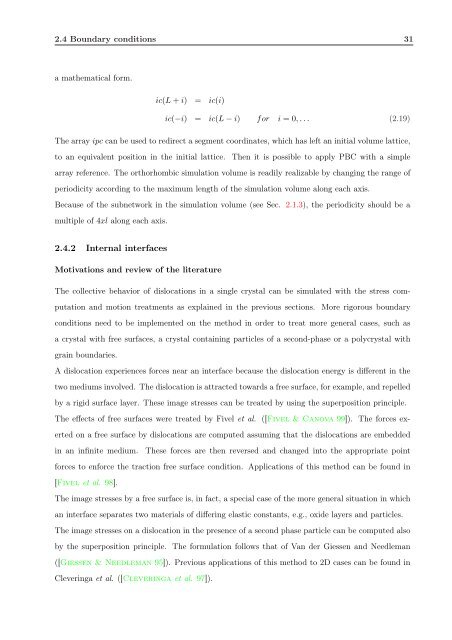3D DISCRETE DISLOCATION DYNAMICS APPLIED TO ... - NUMODIS
3D DISCRETE DISLOCATION DYNAMICS APPLIED TO ... - NUMODIS
3D DISCRETE DISLOCATION DYNAMICS APPLIED TO ... - NUMODIS
You also want an ePaper? Increase the reach of your titles
YUMPU automatically turns print PDFs into web optimized ePapers that Google loves.
2.4 Boundary conditions 31<br />
a mathematical form.<br />
ic(L + i) = ic(i)<br />
ic(−i) = ic(L − i) for i = 0, . . . (2.19)<br />
The array ipc can be used to redirect a segment coordinates, which has left an initial volume lattice,<br />
to an equivalent position in the initial lattice. Then it is possible to apply PBC with a simple<br />
array reference. The orthorhombic simulation volume is readily realizable by changing the range of<br />
periodicity according to the maximum length of the simulation volume along each axis.<br />
Because of the subnetwork in the simulation volume (see Sec. 2.1.3), the periodicity should be a<br />
multiple of 4xl along each axis.<br />
2.4.2 Internal interfaces<br />
Motivations and review of the literature<br />
The collective behavior of dislocations in a single crystal can be simulated with the stress com-<br />
putation and motion treatments as explained in the previous sections. More rigorous boundary<br />
conditions need to be implemented on the method in order to treat more general cases, such as<br />
a crystal with free surfaces, a crystal containing particles of a second-phase or a polycrystal with<br />
grain boundaries.<br />
A dislocation experiences forces near an interface because the dislocation energy is different in the<br />
two mediums involved. The dislocation is attracted towards a free surface, for example, and repelled<br />
by a rigid surface layer. These image stresses can be treated by using the superposition principle.<br />
The effects of free surfaces were treated by Fivel et al. ([Fivel & Canova 99]). The forces ex-<br />
erted on a free surface by dislocations are computed assuming that the dislocations are embedded<br />
in an infinite medium. These forces are then reversed and changed into the appropriate point<br />
forces to enforce the traction free surface condition. Applications of this method can be found in<br />
[Fivel et al. 98].<br />
The image stresses by a free surface is, in fact, a special case of the more general situation in which<br />
an interface separates two materials of differing elastic constants, e.g., oxide layers and particles.<br />
The image stresses on a dislocation in the presence of a second phase particle can be computed also<br />
by the superposition principle. The formulation follows that of Van der Giessen and Needleman<br />
([Giessen & Needleman 95]). Previous applications of this method to 2D cases can be found in<br />
Cleveringa et al. ([Cleveringa et al. 97]).


